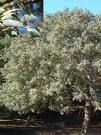California Blue Oak Tree Information
Images of California Blue Oak:






California Blue Oak grows in the following 1 states and provinces:
CaliforniaInformation about California Blue Oak:
The Quercus Douglasii is commonly known as the Blue Oak, California Blue Oak, Iron Oak, Mountain Oak as well as Mountain White Oak.
The currently accepted scientific name of blue oak is Quercus douglasii Hook. & Arn. . There are no recognized subspecies, varieties, or forms. Blue oak hybridizes with the following species: x Q. turbinella Greene spp. californica Tucker (desert scrub oak): Q. Xalvordiana Eastwd. x Q. dumosa Nutt. (California scrub oak) x Q. garryana Dougl. ex Hook. (Oregon white oak): Q. Xeplingii C. H. Mull. x Q. lobata Nee (valley oak): Q. Xjolonensis Sarg. Blue oak is endemic to California. It occurs in valleys and lower slopes of the Coast Ranges and in lower foothills of the Sierra Nevada. Its distribution almost completely encircles the Central Valley .Blue oak-dominated communities are highly variable in composition. Blue oak frequently associates with gray pine (Pinus sabiniana). It also occurs in monospecific stands or codominates with several other oak species. Oak codominants not listed in previous frames include interior live (Q. wislizenii) and valley (Q. lobata) oaks. The blue oak community ranges in physiognomy from open savanna to farily dense woodland with a shrubby understory. It merges or forms a mosaic with annual grassland at low elevation and with chaparral, other oak woodland phases, or singleleaf pinyon-California juniper (Pinus monophylla-Juniperus californica) woodland at higher elevation . The following publications name blue oak as a dominant species: Blue oak communities in California Association types in the North Coast Ranges of California Oak woodland Valley grassland Terrestrial natural communities of California The vascular plant communities of California Plant associations: Overstory associates not previously listed include Coulter pine (Pinus coulteri) and California buckeye (Aesculus californica). Shrub associates include leather oak (Q. durata), California scrub oak (Q. dumosa), buckbrush (Ceanothus cuneatus), California coffeeberry (Rhamnus californica), chamise (Adenostoma fasciculatum), manzanita (Arctostaphylos spp.), poison-oak (Toxicodendron diversilobum), and toyon (Heteromeles arbutifolia). Some common ground cover associates are annual bluegrass (Poa annua), annual fescues (Vulpia spp.), annual ryegrass (Lolium multiflorum), medusahead (Taeniatherum caput-medusae), ripgut brome (Bromus rubens), wild oat (Avena fatua), bur clover (Medicago polymorpha), filaree (Erodium spp.), star thistle (Centaurea spp.), and tarweed (Hemizonia, Holocarpha, and Madia spp.) .Some of the information provided here is attributed to:Howard, Janet L. Quercus douglasii. In: Fire Effects Information System, [Online]. U.S. Department of Agriculture, Forest Service, Rocky Mountain Research Station, Fire Sciences Laboratory (Producer). , available at the USDA Fire Effects Information System (FEIS) website